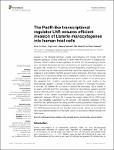The PadR-like transcriptional regulator LftR ensures efficient invasion of Listeria monocytogenes into human host cells
Kaval, Karan G.
Hahn, Birgitt
Tusamda, Nayana
Albrecht, Dirk
Halbedel, Sven
Invasion of the bacterial pathogen Listeria monocytogenes into human host cells requires specialized surface molecules for attachment and induction of phagocytosis. However, efficient invasion is also dependent on factors with house-keeping functions, such as SecA2-dependent secretion of autolysins for post-divisional segregation of daughter cells. Mutations in this pathway prevent degradation of peptidoglycan cross-walls, so that long cell chains are formed that cannot be phagocytosed. The extreme chaining of such mutants manifests as rough colony phenotype. One rough clone was isolated from a transposon library with a transposon insertion in the uncharacterized lmo0720 gene (lftS) together with a spontaneous point mutation in the secA2 gene. We separated both mutations and demonstrated that this point mutation in the intramolecular regulator 2 domain of SecA2 was sufficient to inactivate the protein. In contrast, lftS deletion did not cause a ΔsecA2-like phenotype. lftS is located in an operon with lftR (lmo0719), encoding a PadR-like transcriptional regulator, and lftR deletion affected growth, invasion and day-light dependent coordination of swarming. Inactivation of lftS partially suppressed these phenotypes, suggesting a functional relationship between LftR and LftS. However, the invasion defect of the ΔlftR mutant was only marginally suppressed by lftS removal. LftR regulates expression of the lmo0979–0980 (lieAB) operon, encoding a putative multidrug resistance transporter and lieAB transcription was strongly upregulated in the absence of LftR. Deletion of lieAB in the ΔlftR background restores wild type-like invasion levels. Hence, we conclude that tight transcriptional repression of the lieAB operon is essential for efficient listerial host cell invasion.
Dateien zu dieser Publikation
Keine Lizenzangabe

